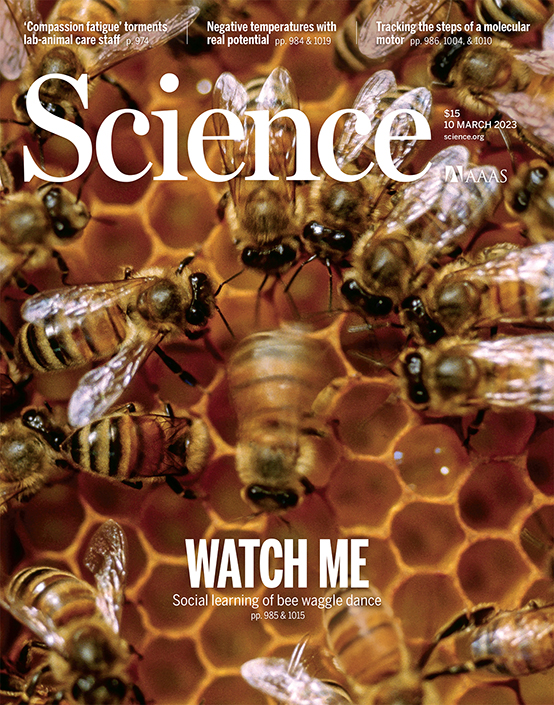Complex Learned Social Behavior Discovered in Bee’s ‘Waggle Dance’
Researchers find that learning and culture are needed for one of the most intricate forms of communication known outside humans
Passing down shared knowledge from one generation to the next is a hallmark of culture and allows animals to rapidly adapt to a changing environment.
While widely evident in species ranging from human infants to naked mole rats or fledgling songbirds, early social learning has now been documented in insects.
Publishing on the cover of the journal Science, a University of California San Diego researcher and his colleagues uncovered evidence that social learning is fundamental for honey bees. Professor James Nieh of the School of Biological Sciences and his collaborators discovered that the “waggle dance,” which signals the location of critical resources to nestmates through an intricate series of motions, is improved by learning and can be culturally transmitted. The study demonstrates the importance of early social signal learning in one of the most complex known examples of non-human spatial referential communication.
“We are beginning to understand that, like us, animals can pass down information important for their survival through communities and families. Our new research shows that we can now extend such social learning to include insects,” said Nieh, a professor in the Department of Ecology, Behavior and Evolution.
Honey bees—like humans, many songbirds and naked mole rats—appear to have a critical period for language acquisition. Honey bees communicate the location of resources such as food through the waggle dance, a form of animal language.
A social insect with a highly organized community structure, honey bees help ensure the survival of their colonies by communicating the location of food sources to one another through a waggle dance in which bees circle around in figure-eight patterns while waggling their bodies during the central part of the dance. Performed at breakneck speed (each bee moves a body length in less than one second), the motions within the dance

translate visual information from the environment around the hive and the location of the sun into the distance, direction and even the quality of the resource to nestmates. Transmitting this information accurately is a remarkable feat because bees must move rapidly across an often uneven honeycomb hive surface.
Nieh and fellow researchers Shihao Dong, Tao Lin and Ken Tan of the Chinese Academy of Sciences (CAS) set up experiments testing the details involved in waggle dance communication. They created colonies to study the information transmission process between skilled forager bees and their younger, less experienced nestmates.
The experimenters created colonies in which bees were never able to observe or follow waggle dancers before they first danced. These colonies consisted of young bees that were all the same age. Bees begin to dance when they reach the right age and always follow experienced dancers before they first attempt to dance. In these experimental colonies, bees were therefore never able to learn from more experienced dancers.
“Bees without the opportunity to follow any dancers before they first danced produced significantly more disordered dances with larger waggle angle divergence errors and encoded distance incorrectly,” the researchers noted in the paper.
“We are beginning to understand that, like us, animals can pass down information important for their survival through communities and families. Our new research shows that we can now extend such social learning to include insects." — James Nieh, Department of Ecology, Behavior and Evolution, School of Biological Sciences.
In contrast, bees that shadowed other dances in control colonies did not suffer from such problems. Like humans, for which early exposure to language development is essential, the bees acquired social cues that were encoded and stayed with them for life (about 38 days). Those that did not learn the correct waggle dance early on were able to improve by subsequently watching other dancers and by practicing, but they were never able to correctly encode distance. This distance encoding creates the distinct “dialects” of different honey bee species. In other words, the bees that could never observe other dancers during their critical early stage of learning developed a new dialect that they maintained for the rest of their lives.
“Scientists believe that bee dialects are shaped by their local environments. If so, it makes sense for a colony to pass on a dialect that is well adapted to this environment,” said Nieh. The results therefore provided evidence that social learning shapes honey bee signaling as it does with early communication in many vertebrate species that also benefit from learning.
With their new results, Nieh and his colleagues now would like to understand the role of the environment in shaping bee language. In the future, they would like to find out if older, more experienced bees in the colony that know the distribution of food sources within their environment might be able to pass on an optimized dialect to the next generation.
They are also concerned that external threats could disrupt this early language learning. Multiple studies, including those by Nieh and his collaborators, demonstrated the harm that commonly used pesticides can inflict on bees.
“We know that bees are quite intelligent and have the capacity to do remarkable things,” said Nieh. “Multiple papers and studies have shown that pesticides can harm honey bee cognition and learning, and therefore pesticides might harm their ability to learn how to communicate and potentially even reshape how this communication is transmitted to the next generation of bees in a colony.”
The research in the Science paper was supported by the CAS Key Laboratory of Tropical Forest Ecology, Xishuangbanna Tropical Botanical Garden, CAS, the CAS 135 program (2017XTBG-T01) and the National Natural Science Foundation of China (No. 31770420).
Publication: Shihao Dong, et al., Social signal learning of the waggle dance in honey bees, Science (2023) DOI: 10.1126/science.adg6020
Original Story Source: UC San Diego

 Alerts Sign-up
Alerts Sign-up